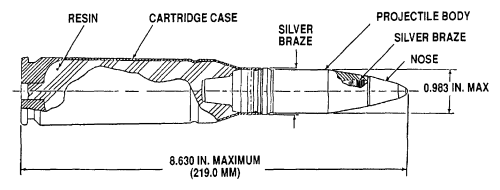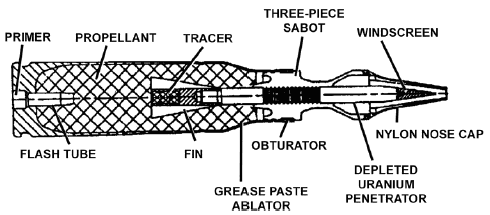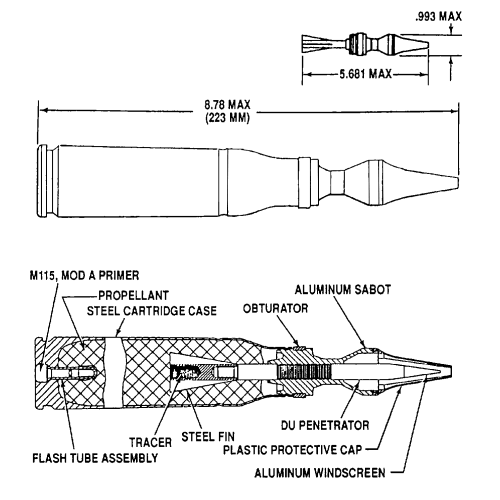The U.S. adopted the 25 mm Oerlikon Type KBA ammunition for use in the M242 gun.
Developed by Oerlikon in the 1960's, this high-performance cartridge can be recognized by the annular link-positioning groove located 98.5 mm from the base of the steel cartridge case.
This groove disappears when the cartridge is fired but leaves an impression on the case.
HEI-T, APDS-T, and multipurpose projectiles are available.
Cartridge data for 25mm ammunition.
| Designations | 25x137, 25 mm Oerlikon Type KBA |
|---|
| Country of Origin | Switzerland |
|---|
| Case Type | Rimless |
|---|
| Case Length | 136.5 mm |
|---|
| Rim Diameter | 37.8 mm |
|---|
| Head Diameter | 38.0 mm |
|---|
| Shoulder Diameter | 35.5 mm |
|---|
| Mouth Diameter | 26.1 mm |
|---|
| Projectile Bourrelet Diameter | 24.8 mm |
|---|
| Cartridge Length | 223 mm |
|---|
| Primer Type | Percussion |
|---|
| The cartridge case has an annular link-positioning groove 98.5 mm from the base of the case. |
Ballistic data for 25mm ammunition.
| |
M791 APDS-T |
M792 HEI-T |
M793 TP-T |
M910 TPDS-T |
M919 APFSDS-T |
|---|
| |
 |
 |
 |
 |
 |
| Muzzle Velocity |
4,413 fps (1,345 mps) |
3,609 fps (1,100 mps) |
3,609 fps (1,100 mps) |
5,003 fps (1,525 mps) |
4,544 fps (1,385 mps) |
|---|
Time of Flight (seconds)
1,000 meters
1,500 meters
2,000 meters
2,500 meters |
0.8
1.2
1.7
2.2 |
1.2
2.2
3.6
5.3 |
1.2
2.2
3.5
5.2 |
0.7
1.2
1.8
2.5 |
0.8
1.2
1.6
2.1 |
|---|
| Cartridge Weight |
16.15 oz (458 g) |
17.67 oz (501 g) |
17.67 oz (501 g) |
14.81 oz (420 g) |
16.01 oz (454 g) |
|---|
| Projectile Weight |
4.73 oz (134 g) |
6.53 oz (185 g) |
6.42 oz (182 g) |
3.35 oz (95 g) |
3.39 oz (96 g) |
|---|
| Propellant |
Radford AP225 |
WC 890 |
WC 890 |
Expro XPR51C4 |
Hercules HES9053 |
|---|
| Primer |
M115 percussion |
M115 Mod A percussion |
|---|
| Tracer Burn Time (seconds) |
>1.7 |
>3.5 |
>3.5 |
>1.8 |
>1.8 |
|---|
Bursting Radius
Arming Distance |
N/A |
16 ft (5 m)
33 to 656 ft (10 to 200 m) |
N/A |
N/A |
N/A |
|---|
| Max Effective Range |
6,562 ft (2,000 m) |
9,842 ft (3,000 m) |
5,249 ft (1,600 m) |
6,562 ft (2,000 m) |
8,202 ft (2,500 m) |
|---|
| Tracer Burn Range |
>6,562 ft (>2,000 m) |
>6,562 ft (>2,000 m) |
>6,562 ft (>2,000 m) |
>6,562 ft (>2,000 m) |
>8,202 ft (>2,500 m) |
|---|
| |
M791 APDS-T |
M792 HEI-T |
M793 TP-T |
M910 TPDS-T |
M919 APFSDS-T |
|---|
M791 Armor-Piercing Discarding Sabot with Tracer (APDS-T)
The M791 APDS-T penetrates lightly armored vehicles, self-propelled artillery, and aerial targets such as helicopters and slow-moving, fixed-wing aircraft.
The APDS-T is a fixed-type, percussion, primed round. It consists of a sabot-encapsulated projectile body crimped to a steel cartridge
case. The projectile body consists of a solid tungsten alloy penetrator, pressed-on aluminum windscreen, pressed-in tracer pellets,
molded discarding-type nylon sabot, staked aluminum base, and welded or pressed-on nylon nose-cap. The projectile sabot and nose-cap
are black with white markings.
Gasses produced by the burning propellant send the projectile from the gun at 1,345 meters per second (plus or minus 20 meters per
second) and ignite the tracer. Setback, centrifugal, and aerodynamic forces cause both the sabot and nose-cap to discard as soon as
the round leaves the barrel. The projectile is spin-stabilized and penetrates the target solely by kinetic energy.
The discarding sabot leaves the barrel at about a 34° angle along the gun-target line (17° off each side) for 100 meters.
The maximum effective range is 2,000 meters due to tracer burnout. Although its tracer burns out at 2,000 meters, an APDS-T round is
accurate out to 2,200 meters. As the range increases, the APDS-T penetration decreases, especially when target vehicles have
applique armor (an added layer of armor).
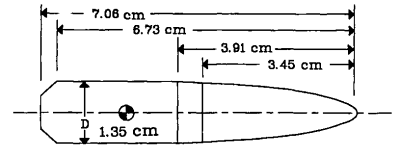

M792 High-Explosive Incendiary with Tracer (HEI-T)
The M792 HEI-T can destroy unarmored vehicles and helicopters and suppress anti-tank guided missile (ATGM) positions and enemy squads
beyond coax range (900 meters) and out to a maximum effective range of 3,000 meters.
The HEI-T cartridge is a fixed-type, percussion-primed round. The one-piece projectile body contains HEI and is crimped onto a steel
cartridge case. The hollowed steel projectile houses an M758 mechanical fuze, 32 grams of an HEI mix, and a pressed-in tracer. The
projectile is yellow with a red band, black markings, and a gold tip. On some rounds, the projectile's yellow color is slightly orange
near the red band.
Gasses produced by the burning propellant send the projectile out of the gun at 1,100 meters per second (plus or minus 20 meters per
second). On impact, the M758 mechanical fuze ignites and the HEI filler detonates. This projects steel fragments from the body,
rotating band assembly, and incendiary filler over a 5-meter radius.
The maximum effective range for HEI-T rounds is 3,000 meters, at which range, a mechanical fuze (the M758) detonates the round.
Accuracy decreases beyond 1,600 meters, and the tracer burns out at 2,000 meters. However, the round's 5-meter bursting radius and
rate of fire let the firer engage either point or area targets out to the maximum effective range.
The M792 HEI-T projectile can detonate in any of three ways:
- Direct Impact. Striking the target crushes the projectile's probe cap. This pushes the probe rearward, which thrusts the firing
pin into the detonator, which detonates the HEI mixture.
- Grazing Impact. Due to spin decay (loss of forward velocity), the projectile strikes the target with insufficient force. Spin
decay triggers the setback spring to overcome centrifugal force, pushes the body assembly forward, and thrusts the detonator into
the firing pin.
- Self-Destruct. If it does not hit a target, the projectile self-destructs at 3,000 meters. However, head and tail winds,
depending on their severity, can reduce the distance at which the round self-destructs.
Type Classification Date: 1980. Unit cost: $49 (Fiscal Year 2007).
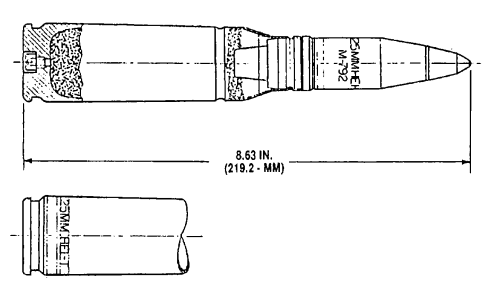


M793 Target Practice with Tracer (TP-T)
The M793 TP-T cartridge is a fixed-type, percussion-primed training round with M28 link that matches the M792 HEI-T round ballistically.
The projectile consists of a hollow steel body with blue with white markings. The TP-T's maximum effective range is 1,600 meters,
and the tracer is visible out to 2,000 meters. However, accuracy is greatly reduced beyond 1,600 meters.
This is a training item and is not used in combat.
Type Classification Date: 1979. Unit cost: $17 (Fiscal Year 2004/2005).

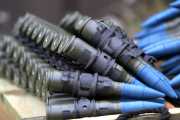
Rodriguez Live Fire Complex, Republic of Korea
27-MAR-2007
U.S. Marine Corps Photo
1800x1200, 467K, JPEG
M794 Dummy
The M794 dummy cartridge is used for non-firing system checkout for the M242 25mm automatic cannon and training of the crew.
The cartridge is a modified M793 target practice with tracer (TP-T) projectile silver brazed to a modified standard cartridge case and is completely inert.
The cartridge case cavity is filled through an enlarged primer hole with an epoxy resin filler to approximate the weight of the M792 high explosive incendiary-tracer and M793 TP-T service cartridges.
The threaded nose of the TP-T projectile is silver brazed to the projectile body to improve physical integrity.
The external configuration of the M794 metal dummy cartridge (by use of standard components) is the same as that of the M792 HEI-T and M793 TP-T service cartridges.
These cartridges are linked together by the M28 link.
This is a training item and is not used in combat.
Type Classification Date: December 1981. Unit cost: $36 (Fiscal Year 2007).
M910 Target Practice Discarding Sabot with Tracer (TPDS-T)
The target-practice, discarding sabot with tracer (TPDS-T) replicates the flight pattern of the M791 APDS-T round. The TPDS-T allows
units to practice sabot engagements on limited-distance ranges. The maximum range of the TPDS-T is 6,404 meters.
The TPDS-T cartridge is a fixed type, percussion-primed round. It consists of a sabot-projectile assembly crimped to a steel cartridge
case. The projectile assembly includes a disposable aluminum pusher base. It also includes a subprojectile encapsulated with a
discarding nylon sabot and polyethylene protective cap. The subprojectile has a steel core with either an aluminum or a steel
windscreen and with pressed-in tracer pellets. The projectile is blue with white markings.
Gases produced by the burning propellant discharge the projectile from the gun at 1,540 meters per second (plus or minus 20 meters per
second) and ignite the tracer. Setback, centrifugal force, and air pressure cause the sabot to discard on leaving the gun barrel. The
projectile is spin-stabilized and penetrates the target solely by kinetic energy.
The discarding sabot may cause death or injury along a 34° angle along the gun-target line for 100 meters.
The TPDS-T cartridge trajectory ballistically matches the APDS-T plus or minus 1 mil to a range of 2,000 meters.
The tracer burns out at 2,000 meters.
Type Classification Date: 1988. Unit cost: $16 (Fiscal Year 2004/2005).


M910E1 Target Practice Discarding Sabot with Tracer (TPDS-T)
The M910E1 will provide an improved target practice cartridge for the M919 APFSDS-T cartridge. The trajectory will be ballistically
similar to the M919 and possess a similar tracer signature to the M919 cartridge when viewed through the Bradley Fighting Vehicle's
Improved Bradley Acquisition System. The M910E1 will replace the current M910 TPDS-T cartridge (designed to be ballistically similar
to the M791) as the training round for both the M919 and the M791.
The M919 service cartridge contains a DU penetrator and is not used for training.
The M919 and M791 service cartridges exceed the maximum range requirement for most training ranges.
This is a training item and is not used in combat.
Type Classification Date: Limited Production, November 2004. Standard, May 2005. Unit cost: $20 (Fiscal Year 2004/2005).
M919 Armor-Piercing, Fin-Stabilized Discarding Sabot With Tracer (APFSDS-T)
The armor-piercing, fin-stabilized discarding sabot with tracer (APFSDS-T) round penetrates lightly armored vehicles, self-propelled
artillery, and aerial targets, which includes helicopters and slow-moving fixed-wing aircraft.
The APFSDS-T is a fixed-type, percussion primed round that consists of a sabot-encapsulated projectile crimped into a steel cartridge
case. The projectile is made of slate gray, corrosion-protected, depleted uranium. It has a screw-on steel fin with pressed-in tracer
pellets; a three-piece, segmented aluminum sabot and a snap-on plastic protective cap. The projectile sabot and protective nose-cap are
black, and the slip-band nylon obturator is white. The round has a green rubber sealant between the sabot segments, the sabot and
penetrator, and the sabot and the plastic cap.
Gases produced by the burning propellant discharge the projectile from the gun at 1,385 meters per second (plus or minus 20 meters per
second) and ignite the tracer. Setback, centrifugal force, and air pressure cause the sabot to discard on leaving the gun barrel.
The projectile is fin-stabilized and penetrates the target solely by kinetic energy.
The discarding sabot leaves the barrel at a 17° angle on both sides of the gun-target line for 100 meters (total of 34°).
The M919 APFSDS-T round has greater effective range, penetration capabilities, and tracer burn time than the APDS-T (M791).
The M919 replaces the M791 as the primary armor-piercing cartridge for use in the 25mm M242 Bushmaster. The M919 cartridge
significantly increases the lethality of the M242 against all threat infantry fighting vehicles. The M791 does not defeat the existing
threat. The M919 state-of-the-art armor defeat mechanism, combined with a high muzzle velocity, yields a very high kill probability for
firing at stationary and moving threat targets. The M919 is the only 25mm "long-rod" penetrator produced for the M242 cannon.
The M919 provides the soldier greater standoff, thus increasing battlefield survivability for the vehicle and accompanying infantry.
The M919 provides the soldier with the lethality needed to defeat the enemy, accomplish the mission, and to survive on today's modern battlefield.
Exposure to M919 ammunition results in exposure to low level radiation.
The amount of radiation the soldier receives is proportional to the amount of time spent in the vicinity of M919 ammunition.
Although the radiation exposure received is low and considered safe, avoid unnecessary contact with packaged APFSDS-T M919 ammunition, within mission constraints.
Type Classification Date: Limited Production Urgent, September 1989. Standard, September 1993. Unit cost: $98 (Fiscal Year 2004/2005).


XM1021 Break-Up Cartridge
The XM1021 utilizes a projectile with a plastic jacket loaded with pressed iron powder tablets in the main body and polystyrene foam
in the nose. Upon firing of the Break-up cartridge, the projectile jackets ruptures and the iron powder and the projectile jacket fall
to the ground within 75-100 meters from the weapon. Neither a test facility with bullet trap nor a full scale range is necessary to
perform the verification functional check prior to deployment.
M242 Gun Prime Item Specification approved: January 1997.


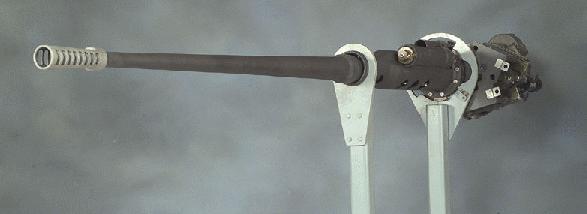


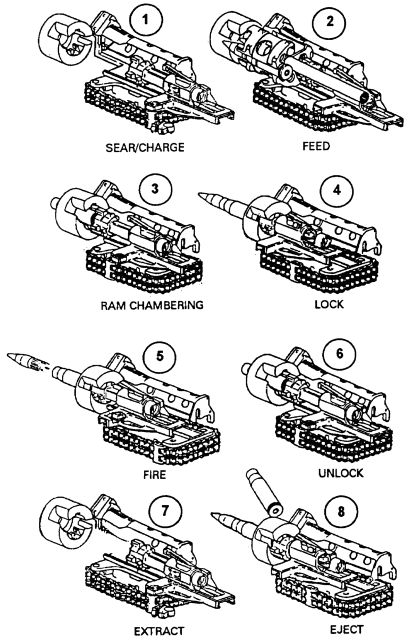

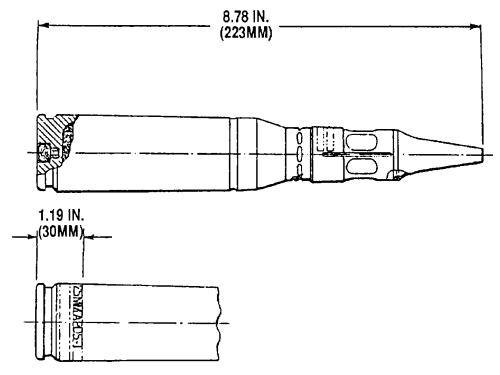


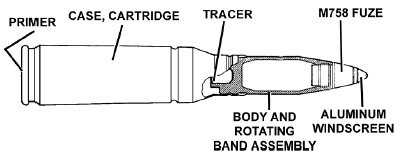



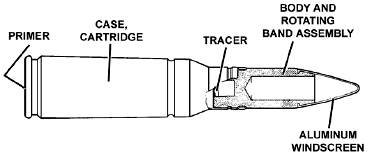
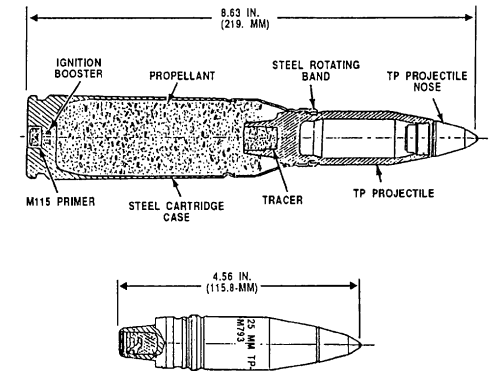

 Rodriguez Live Fire Complex, Republic of Korea
Rodriguez Live Fire Complex, Republic of Korea 